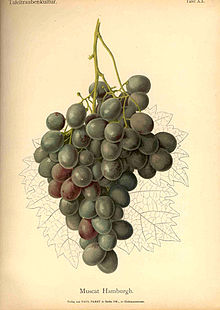
Back Хамбургски мискет Bulgarian Muscat de Hambourg German Moscatel negro Spanish Muscat de Hambourg French Hamburgi muskotály Hungarian Moscato d'Amburgo Italian Muscat de Hamburg Romanian Мускат гамбурзький Ukrainian
| Black Muscat | |
|---|---|
| Grape (Vitis) | |
 Rudolf Goethe: Handbuch der Tafeltraubenkultur | |
| Species | Vitis vinifera |
| Also called | Golden Hamburg, Muscat Hamburg, Black Hamburg (US); Muscat de Hambourg (France); Moscato di Amburgo (Italy); Muscat Gamburgskiy (Russia) |
| Origin | England |
| Notable regions | California, Virginia, Pacific Northwest, Vancouver Island, India, China, Eastern Europe |
| VIVC number | 8226 |

Black Muscat (or Muscat Hamburg) is a red Vitis vinifera grape variety derived from the crossing of the Schiava Grossa and Muscat of Alexandria by Seward Snow, Head Gardener to Earl de Grey at Wrest Park, Bedfordshire UK in 1850, according to the Vitis International Variety Catalogue. It is known under a variety of local names such as Golden Hamburg, and Black Hamburg in the US; Muscat de Hambourg (or Hamburgh) in France; Moscato di Amburgo in Italy; and Muscat Gamburgskiy in Russia and former Soviet Union countries. Confusingly, Black Hamburg is also used as a synonym for its maternal parent. It is commonly produced as table wine but in California's Central Valley it has been used in the production of dessert wine. As a dessert wine it can be highly aromatic with a rich coloring. In the US it is grown in wine appellations in California, Virginia, Oregon, Texas, and Washington. In Canada, it is also found on Vancouver Island.[1]
In France, the grape is used chiefly as dessert grape including AOC varieties such as Muscat du Ventoux. In Eastern Europe, the grape produces a light, dry red wine. It is also starting to gain popularity as a table wine component in China.[2]
One of the world's southernmost grapevines, at the conservatory of Government House in the Falkland Islands, is of the Black Muscat variety.[3]
Horticulturist Walter Clore has postulated that this grape might have been one of the first Vitis vinifera varieties planted in Washington State in the early 19th century.[4]
- ^ Appellation America Grape details.
- ^ Jancis Robinson: Vines, Grapes & Wine, p. 188. Octopus Publishing 1986 ISBN 978-1-85732-999-5.
- ^ Bernhardson, Wayne (28 November 2013). "Grapes in the Falklands? At Government House Gardens". Southern Cone Travel. Retrieved 2022-09-08.
- ^ R. Irvine & W. Clore: The Wine Project, p. 38. Sketch Publications 1997 ISBN 978-0-9650834-9-2.